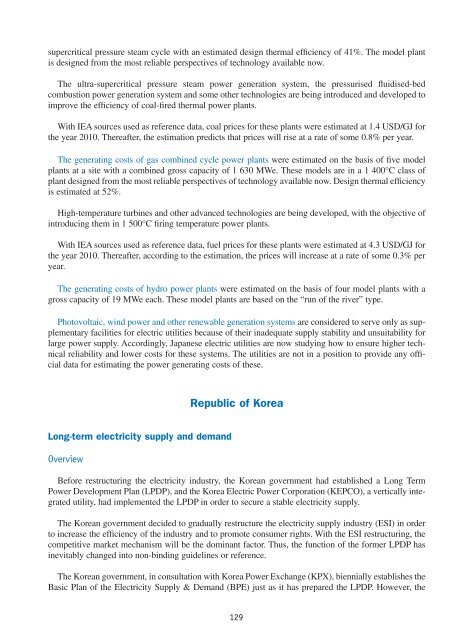Projected Costs of Generating Electricity - OECD Nuclear Energy ...
Projected Costs of Generating Electricity - OECD Nuclear Energy ...
Projected Costs of Generating Electricity - OECD Nuclear Energy ...
You also want an ePaper? Increase the reach of your titles
YUMPU automatically turns print PDFs into web optimized ePapers that Google loves.
supercritical pressure steam cycle with an estimated design thermal efficiency <strong>of</strong> 41%. The model plant<br />
is designed from the most reliable perspectives <strong>of</strong> technology available now.<br />
The ultra-supercritical pressure steam power generation system, the pressurised fluidised-bed<br />
combustion power generation system and some other technologies are being introduced and developed to<br />
improve the efficiency <strong>of</strong> coal-fired thermal power plants.<br />
With IEA sources used as reference data, coal prices for these plants were estimated at 1.4 USD/GJ for<br />
the year 2010. Thereafter, the estimation predicts that prices will rise at a rate <strong>of</strong> some 0.8% per year.<br />
The generating costs <strong>of</strong> gas combined cycle power plants were estimated on the basis <strong>of</strong> five model<br />
plants at a site with a combined gross capacity <strong>of</strong> 1 630 MWe. These models are in a 1 400°C class <strong>of</strong><br />
plant designed from the most reliable perspectives <strong>of</strong> technology available now. Design thermal efficiency<br />
is estimated at 52%.<br />
High-temperature turbines and other advanced technologies are being developed, with the objective <strong>of</strong><br />
introducing them in 1 500°C firing temperature power plants.<br />
With IEA sources used as reference data, fuel prices for these plants were estimated at 4.3 USD/GJ for<br />
the year 2010. Thereafter, according to the estimation, the prices will increase at a rate <strong>of</strong> some 0.3% per<br />
year.<br />
The generating costs <strong>of</strong> hydro power plants were estimated on the basis <strong>of</strong> four model plants with a<br />
gross capacity <strong>of</strong> 19 MWe each. These model plants are based on the “run <strong>of</strong> the river” type.<br />
Photovoltaic, wind power and other renewable generation systems are considered to serve only as supplementary<br />
facilities for electric utilities because <strong>of</strong> their inadequate supply stability and unsuitability for<br />
large power supply. Accordingly, Japanese electric utilities are now studying how to ensure higher technical<br />
reliability and lower costs for these systems. The utilities are not in a position to provide any <strong>of</strong>ficial<br />
data for estimating the power generating costs <strong>of</strong> these.<br />
Republic <strong>of</strong> Korea<br />
Long-term electricity supply and demand<br />
Overview<br />
Before restructuring the electricity industry, the Korean government had established a Long Term<br />
Power Development Plan (LPDP), and the Korea Electric Power Corporation (KEPCO), a vertically integrated<br />
utility, had implemented the LPDP in order to secure a stable electricity supply.<br />
The Korean government decided to gradually restructure the electricity supply industry (ESI) in order<br />
to increase the efficiency <strong>of</strong> the industry and to promote consumer rights. With the ESI restructuring, the<br />
competitive market mechanism will be the dominant factor. Thus, the function <strong>of</strong> the former LPDP has<br />
inevitably changed into non-binding guidelines or reference.<br />
The Korean government, in consultation with Korea Power Exchange (KPX), biennially establishes the<br />
Basic Plan <strong>of</strong> the <strong>Electricity</strong> Supply & Demand (BPE) just as it has prepared the LPDP. However, the<br />
129

















